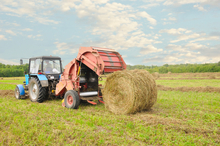The crisp, cool temperatures of fall are delightful for human and horse alike. But as nature slips toward a dormant state, hay becomes the forage of choice for most horses. Hay is dead grass. Once fresh grass is cut, dried, and stored as hay, its vitamin content, along with valuable omega 3 fatty acids, dramatically declines, making supplementation necessary to fill in nutritional gaps.

Making the transition from pasture to hay
To prevent digestive health problems, be consistently consistent with your horse’s care and feeding, make slow transitions, and allow your horse to be a horse.
Plus, hay has very little moisture compared to fresh pasture. Most hay contains approximately 90 to 95% dry matter (only 5 to 10% water), compared to fresh pasture with moisture levels often exceeding the dry matter content. Therefore, as hay becomes a larger percentage of your horse’s diet, colic risk significantly increases.
Colic basically means a “stomach ache.” It could simply be a mild disturbance, or severe enough to be life threatening. It is the number two killer of horses, number one being old age! Colic isn’t actually a disease; it’s a symptom of another problem.
With increased hay consumption, impactions and excess gas production are the most common causes. Enteroliths (stones) are often seen in high alfalfa hay diets. And ulcers often develop when a horse is transferred from day-long turnout, to longer periods of time in the stall.
Here are some important ways ease the transition and avoid colic
- Simulate the horse’s natural need to graze by providing hay 24/7. Horses that experience an empty stomach between time-separated hay meals will eat their hay very quickly. Horses that are offered hay free-choice will learn that there is always hay available and they will eat more slowly and self-regulate their intake to eat only what they need to maintain condition.
- Limit winter stalling. Colic episodes increase when horses are brought in from pasture. Being outdoors provides needed exercise to keep the digestive tract muscles in tone.
- Make changes gradually. This will give the bacterial flora in the hindgut a chance to become accustomed to the forage source.
- Offer a prebiotic. A prebiotic contains fermentation products rather than live microbes, which feed the existing population in the hindgut. This makes forage digestion more efficient.
- Provide clean, tepid water. Icy cold water is often rejected, leading to decreased fluid in the digestive tract. It is best to heat the water supply to approximately 50° F to ensure enough consumption.
- Don’t forget the salt. Salt is needed year round. A full sized horse requires approximately 2 tablespoons (one ounce or 28 grams) of table salt per day, divided between meals, to encourage him to drink to prevent impactions. Salt blocks are often ignored because of the discomfort that constant licking creates. Consider offering table salt, free choice, by pouring some in a nearby bucket.
- Have your horse’s teeth floated annually. Poor dental health leads to partially chewed hay, which can cause impactions throughout the digestive tract.
- If possible, have your hay analyzed. If you have two months’ supply or more, it is worth having your hay analyzed for its sugar and starch content, as well as the protein, minerals, and selenium levels.
In summary, continuous grazing without gaps will keep the intestinal motility normal, prevent acid buildup, and protect the vital forage-digesting hindgut microbes. Reduced water consumption (due to increased dry matter in hay and/or cold water temperature) is one of the main causes of colic in the winter.
To prevent digestive health problems, be consistently consistent with your horse’s care and feeding, make slow transitions, and allow your horse to be a horse just as much throughout the cold months as you do during the summer.
About Dr. Getty
Juliet M. Getty, Ph.D. is an internationally respected, independent equine nutritionist who believes that optimizing horse health comes from understanding how the horse’s physiology and instincts determine the correct feeding and nutrition practices. She is available for private consultations and speaking engagements.
Dr. Getty’s comprehensive resource book, Feed Your Horse Like a Horse, is available at Dr. Getty’s website, www.gettyequinenutrition.com, as well as from Amazon (www.Amazon.com) and other online book retailers. The seven separate volumes in Dr. Getty’s topic-centered “Spotlight on Equine Nutrition” series are also available at her website, where Dr. Getty offers special package pricing, and from Amazon (in print and Kindle versions) and from other online retailers.
Dr. Getty’s website, www.gettyequinenutrition.com, offers a generous stock of free, useful information for the horseperson. Sign up for her free monthly newsletter, Forage for Thought; browse her library of reference articles; search her nutrition forum; and purchase recordings of her educational teleseminars. Plus, for the growing community of horse owners and managers who allow their horses free choice forage feeding, Dr. Getty has set up a special forum as a place for support, celebrations, congratulations, and idea sharing. Share your experiences at jmgetty.blogspot.com. Reach Dr. Getty directly at gettyequinenutrition@gmail.com.
